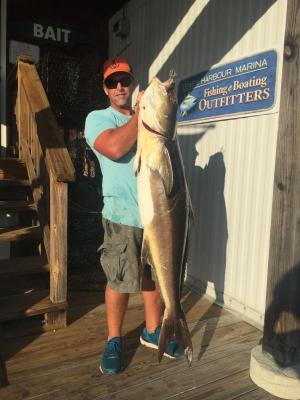The Flounder Pounder Tournament, held last weekend out of Paradise Grill on Long Neck, attracted 182 boats and produced some very big flounder. The first-place fish weighed 11.93 pounds and was caught by Tony Munoz on the J Hook. It was worth $50,000. Second place weighed 9.96 pounds and was worth $30,000. It was caught by Antonio Marsico. Coming in third was Dave Walker with a 9.54-pound flounder worth $10,000.
Fishing report
Flounder fishing in Delaware Bay is improving, with those who learn how to jig over the rubble at the reef sites catching a fair number of fish. We also had reports of a few flounder caught in the old haunts like A Buoy at the Anchorage. Bucktails with Gulp! or strips of squid or fish have produced well at the reef sites. A live minnow and a strip of squid on a Delaware Bay Green Machine will work over open bottom at the Anchorage.
Small bluefish are in good supply in the bay with some of the best action found at the south end of the Outer Wall on outgoing current. Casting small metal lures is a good technique for these fish.
Bottomfish, such as small croaker, kings and blowfish, are around the reef sites and along the inside and outside of the Outer Wall. Bloodworms and clam will be the best baits for these fish.
The Outer Wall and the Ice Breakers hold spadefish and sheepshead. Sand fleas work best for the sheepshead while spadefish like small bits of clam on a small hook. Chumming with clam can bring in the spades and put them in a feeding mood.
The fishing pier at Cape Henlopen State Park has been seeing small croaker and spot. The same is true for the Lewes-Rehoboth Canal. Here too, bloodworms or clam work best.
Last week, flounder fishing in the ocean was fantastic! Limit catches were common and there were lots of fish over five pounds. All the reef sites from 9 to 11 produced fish, as did the Old Grounds and the rough bottom at B and A buoys. The cool front that moved by on Sunday night should not have any effect on this fishing, at least I hope it won’t.
One of the more interesting things associated with the good flounder fishing is the bycatch of keeper sea bass and the occasional dolphin. I have caught dolphins this close to shore in the past and it is always a pleasant surprise. I would suggest having a spinning rod rigged up and ready in case a dolphin cruises by. A white bucktail is as good as anything and if you can tip it with squid, Gulp!, or a strip of fresh fish so much the better.
Another fish that has been a pleasant surprise is the cobia. Several have been caught this year including a 63.3-pounder taken by Jacob Webb. I am sure the warm water plus the abundant supply of menhaden has drawn them up to our region.
Dolphin and wahoo have been caught over lumps and ridges from the Lightship on out to Massey’s Canyon. This is a trolling bite and with the inshore tuna run over, the number of boats working this area has diminished significantly.
I have no idea how many blues have been caught at Fenwick Island, but with most boats catching their 10-fish limit, and that’s with six people fishing, the number is pretty high. Even so, they are still there, and the numbers don’t seem to diminish. Trolling with Huntington Drone #0 spoons behind a trolling sinker or #1 planer has been the best technique for catching these blues. The number of Spanish mackerel caught along with the blues is much less than it was earlier in the summer.
Inshore wrecks hold flounder, triggerfish and porgies. Triggers and porgies will take clams or small bits of cut bait. Jigging with a bucktail is the best way to work a wreck for flounder.
My reports indicate the marlin bite was off last week. I figure they all had sore mouths after well over 1,000 of them were caught during the White Marlin Open.
The Indian River Inlet has seen a few more keeper flounder. The same locations along the north and south sides remain the best producers. The moon is coming off of full, so currents should be less than during last week’s full moon. In theory this should make it easier to fish the deep water at the Old Grounds, but few fish understand human theory. The marlin bite in the canyons should also improve since everyone knows billfish don’t feed during the day when the moon is full.
And so it goes.





















































